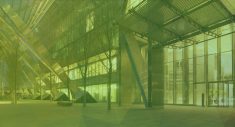The word green has been so over-used recently that it has become almost a cliché for promotional purposes and easy consent. Nevertheless, the word can’t be constrained to its mere ecological significance, i.e., environmental sustainability or energy efficiency, but it has to include wellbeing among its meanings.
What is the Human Centered
Design Now that people are more aware of what it means to be responsible towards the environment, it is time to promote a new vision of built environment where the main goal is the occupant’s wellbeing. A Human Centered Design (HCD) that focuses on how occupants react emotionally e cognitively to different spatial parameters must be taken in consideration and promoted. Highly performative buildings, complying with environmental and energetic standards, don’t necessarily fulfill these requirements by themselves.
More than 2000 years ago Vitruvius wrote about “utilitas”, “venustats” and “firmitas” to indicate the main principles for a good design practice, but something went wrong in the past centuries, when the industrial revolution has enhanced some technological aspects while forgetting others. For example, hospital have become aseptic places in the name of hygiene issues and working places have sacrificed individuality of employees in the name of productivity.
Most green building certification systems consider different physical parameters as essential to provide a comfortable environment through air quality, light control and temperature, but still they lack considering some effects in the long run. Let us take for example lighting: there is a great difference between the gradual variation of lux in outdoor daylight and the constant values offered by artificial indoor lighting systems in a workspace. Recent discoveries have found that the effects of a long and inadequate lighting exposure can trigger depression and mental-as well as general health- disorders (Lewy AJ 1982, D. E. Blask 2014).
Biological reaction to indoor environments
Emotional reactions are in many ways linked to our body metabolism, but also to our multisensory perceptions. Recent publications focused on the interdisciplinarity between neuroscience and architecture stimulate a new integrative design approach which can conceive regenerative spaces other than being just respectful of codes and standards (Mallgrave 2011, Eberhard 2009). With these newly acquired knowledge, buildings are not just “safe” and “comfortable” but can promote wellbeing.
Neuroscience plays a great role in understanding and discovering the causes that trigger or eliminate the biological reactions to the environment and the complexity of our multisensory perception.
Our biological structure isn’t the only factor to determine our perception of the surrounding reality, but culture and education do influence and shape the way we experience the environment in a unique and individual way. Therefore, we cannot expect that neuroscience dictates new rules for design, but it can provide important reference points from which architects can hypothesize better solutions. Our genes establish the premises of our physical identity when we are conceived, but still our individuality is more broadly subject to the influences of the environment we live in, in an open-ended process that is difficult to forecast precisely, but whose aspects should be taken into account in the design process, in order to achieve healthier solutions for our mind and body.
Cognitive Wellness
Hopefully a new paradigm for design, where architecture and neuroscience interface with each other in a collaborative path, can provide a new vision in which schools can help children to be more focused, working places can make employees happier and more creative, and, in general, all spaces can provide adequate emotional and cognitive wellness.




